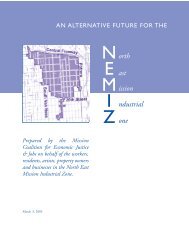INDUSTRIAL LAND IN A POST-INDUSTRIAL CITY District of ...
INDUSTRIAL LAND IN A POST-INDUSTRIAL CITY District of ...
INDUSTRIAL LAND IN A POST-INDUSTRIAL CITY District of ...
You also want an ePaper? Increase the reach of your titles
YUMPU automatically turns print PDFs into web optimized ePapers that Google loves.
<strong>District</strong> <strong>of</strong> Columbia Industrial Areas Study DC Office <strong>of</strong> Planning<br />
Prepared by Phillips Preiss Shapiro Associates, Inc.<br />
4.6.4.2 Distributed Generation<br />
Distributed generation (DG) refers to using local sources <strong>of</strong> energy production and distribution<br />
for power, rather than large, centralized facilities like fossil fuel plants. While DG can utilize<br />
conventional fuels, its real potential lies with easily obtainable energy from renewable sources<br />
like solar, wind, biomass, and tidal currents. DG facilities can generally be installed on buildings,<br />
meaning that no additional space is required. Because power is generated close to its where it<br />
will be used, transmission losses are minimized. Further, DG eliminates the need for gigantic,<br />
highly secure power plants, like the peaking plants found at Benning Road and in Buzzard<br />
Point. Instead, these vast swaths <strong>of</strong> industrial land could be made now available for<br />
employment-generating PDR uses.<br />
Municipal landfills and sewage plants are man-made sources <strong>of</strong> methane, or natural gas. Some<br />
municipalities have looked at the potential for generating electrical power from methane evolved<br />
from landfills. The same potential may exist for a methane-driven power plant capitalizing on<br />
waste gas from the Blue Plains water treatment facility. The benefits are tw<strong>of</strong>old—capturing a<br />
“free” source <strong>of</strong> energy, and combusting a greenhouse gas more potent than carbon dioxide.<br />
This alternative energy source could further reduce the need for large “dirty” power plants.<br />
4.6.4.3 Green Buildings, Green Planning<br />
Green building and planning standards and technologies are aimed at finding low-energy, more<br />
natural solutions to the problems common to all development: heating and cooling, disposing <strong>of</strong><br />
liquid and solid wastes, managing stormwater flows. While this topic may seem unrelated to<br />
industrial land, it does in fact address directly issues related both the efficient deployment <strong>of</strong><br />
municipal resources and the ability to accommodate future growth without overstressing the<br />
<strong>District</strong>’s infrastructure.<br />
As more and more people live and work in the <strong>District</strong>, demands on the <strong>District</strong>’s sewers and<br />
Blue Plains wastewater treatment plant will grow. Blue Plains has the capacity to absorb this<br />
demand, but large rainfall events flood the <strong>District</strong>’s older combined sanitary/storm sewers and<br />
run<strong>of</strong>f pours, untreated, into rivers. To alleviate this, WASA is retr<strong>of</strong>itting its system to separate<br />
water and storm sewers in the few areas where they are still combined, but additional storm<br />
water management and retention strategies should be pursued, especially in industrial areas<br />
where run<strong>of</strong>f tends to be toxic.<br />
The Office <strong>of</strong> Planning guidelines for “green” development in NoMa are important steps in the<br />
right direction. Recognizing that intense development could have considerable environmental<br />
impacts, OP notes that certain strategies should be investigated to reduce demand on an<br />
already overburdened water management system. Strategies could include rainwater collection<br />
and reuse (which has the potential to decrease costs for water-heavy PDR businesses),<br />
increasing permeable surfaces and decreasing hardscapes like parking lots (car sharing and<br />
transit would reduce auto use and space lost to parking lots), and using bioswales and green<br />
ro<strong>of</strong>s and other buffers to control, channel, filter, and mitigate run<strong>of</strong>f. These strategies not only<br />
- 109 -












